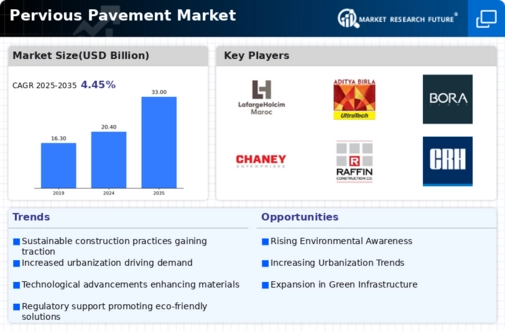Market Analysis
In-depth Analysis of Pervious Pavement Market Industry Landscape
Permeable materials allow runoff water to infiltrate the soil preventing erosion and also eliminate drainage areas problems. The excessive construction and deforestation in many towns and cities have contributes a lot to the water runoffs. It has now come to be that a reliable water management system is essential, particularly in regions that experience frequent floods and storms. Through absorbing excess water, pervious pavements will transform such complications into a one-stop solution. Because, it facilitates water flowing into the soil and that creates natural cleansing. This feature has a deployment effect on the pervious pavement industry to expand in regions where water run-offs and soil erosions have been existing problems.
Nowadays, the pavement market is strongly influenced by a lot of factors that both facilitate and obstruct the supply and demand in the industry. A pervious pavement, which can be also called permeable or porous pavement, is a modern and environmental pavement that is an alternative to the traditional impermeable surfaces. Among the main reasons influencing the market outlook is the creating focus on sustainable development and stormwater management in the urban environment. As cities and municipalities aim at designing solutions to mitigate the urbanization impact on water runoff, there has been a growing demand for the pervious paving which has in turn created a positive impact on the dynamics of the construction and infrastructure market.
Construction and infrastructure industry is a key facet that guides the market trends for permeadable pavements. In other words, with the demand for sustainable and resilient infrastructure growing, pervious pavement has gradually been used in cases such as sidewalks, parking lots, and driveways. The function of pervious pavements as a means of stormwater runoff suppression, flood prevention and water quality improvement results in a major influence on market dynamics within the construction market.
In addition to that, environmental considerations and sustainable practices also play an important role in regards to market dynamism. Pervious paving is created to allow water to filter through the surface to the soil beneath. Consequently, stormwater infiltration decreases surface runoff, recharges groundwater levels, and filters pollution before it reaches water bodies. As manufacturers and developers that focus on sustainable building techniques solve the problem of market dynamics which in turn provide solutions that meet the increasing demand for environmentally friendly and robust pavement options.
Innovations of existing technology in pervious pavement design are in line with market dynamics. Research and development efforts in this sector have been going on steadily and these aim to address the problem of durability, load-bearing capacity, and overall performance of pervious pavement systems. The innovation of such inventions as better mix designs, additives, and installation techniques drives the market change by empowering construction experts with more efficient and robust solutions.










Leave a Comment